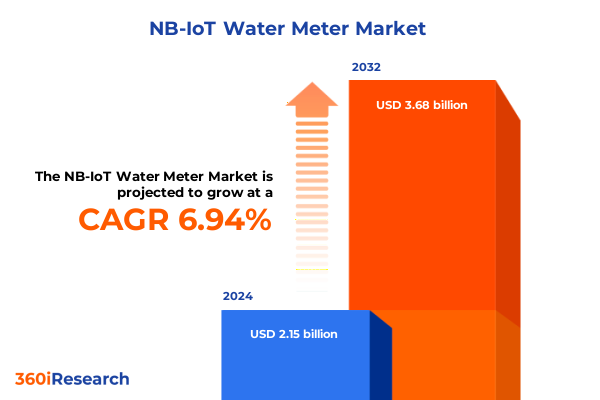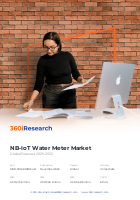The NB-IoT Water Meter Market size was estimated at USD 2.15 billion in 2024 and expected to reach USD 2.26 billion in 2025, at a CAGR of 6.94% to reach USD 3.68 billion by 2032.

Pioneering the Future of Water Management with NB-IoT Technology Driving Intelligent Resource Optimization and Operational Efficiency
Water scarcity has emerged as a critical global challenge, driven by accelerating urbanization, shifting climate patterns, and mounting competition for finite resources. According to a report by the United Nations Conference on Trade and Development, leveraging digital technologies such as the Internet of Things (IoT) and smart metering is central to improving water management efficiency and ensuring safe water access for all stakeholders . Meanwhile, GSMA’s analysis of urban water initiatives underscores how large-scale deployments of smart water meters have delivered substantial reductions in non-revenue water and billing delays, illustrating the transformative potential of digital innovation in water utilities .
Navigating Crucial Industry Transformations as Digital Connectivity, Sustainability Mandates, and Infrastructure Modernization Reshape Water Metering
The water metering landscape is undergoing a profound transformation as digital connectivity converges with sustainability imperatives. IoT-enabled smart meters now serve as the backbone of modern water networks, collecting granular consumption data in real time and enabling remote monitoring at unprecedented scale. Industry observers highlight that sensor-to-value chains, which integrate acoustic leak detection with analytics platforms, are delivering measurable performance gains in utilities across Europe and the Americas . Furthermore, rising regulatory mandates and environmental standards, exemplified by UN-backed digital water programs, are compelling municipalities to adopt metering solutions that meet rigorous data transparency and carbon reduction criteria . In parallel, climate resilience considerations and infrastructure renewal initiatives are driving investments in LPWAN technologies like NB-IoT that can support long-term deployment in both urban and remote areas, reducing maintenance burdens and fortifying water networks against environmental stresses .
Assessing the Layered Effects of United States Tariff Policy Shifts in 2025 on NB-IoT Water Meter Manufacturers and Supply Chains
The United States’ evolving tariff regime is reshaping cost structures for NB-IoT water meter manufacturers and their component suppliers. In May 2024, the USTR extended exclusions on key Chinese imports-including DC motors and communication modules integral to smart metering-only through mid-2025, creating uncertainty in sourcing strategies and production planning . Subsequently, on January 1, 2025, Section 301 tariffs on semiconductors escalated to 50 percent, directly affecting the cost of NB-IoT chipsets used in water meters and raising questions about margin preservation and pricing models . More recently, the 90-day reciprocal tariff reduction agreement enacted on May 14 2025 lowered overarching rates to 10 percent but explicitly maintained Section 301 duties, underscoring the layered and ongoing nature of tariff exposure for metering device producers .
Unveiling Strategic Market Segmentation Insights Based on End Users, Meter Types, Connectivity Modes, Pipe Sizes, Materials, and Installation Locations
When examining end-user verticals, the NB-IoT water meter landscape reveals municipal utilities as the primary adopters, prioritizing leak detection and network optimization, while industrial and commercial users increasingly demand high-precision ultrasonic and vortex meter types to manage process water with minimal downtime. In parallel, a nuanced breakdown of meter technologies shows strong interest in electromagnetic solutions-available in both full-bore and insertion variants-for large diameter pipelines, whereas static multi-jet and single-jet meters continue to serve residential applications where cost-efficiency and ease of installation are paramount. Transitioning to connectivity considerations, utilities are weighing guard-band deployments for dedicated performance against in-band and standalone NB-IoT modes that leverage existing LTE infrastructure or operate in isolated spectrums to mitigate interference. Equally significant is the influence of pipe sizing on device selection, as 15–25 mm and 25–40 mm lines call for compact meters, whereas segments above 40 mm justify investment in robust electromagnetic devices. Material composition also plays a critical role, with brass favored for durability in urban settings, plastic gaining ground in corrosive environments, and stainless steel securing the highest reliability in industrial contexts. Finally, location factors drive the choice between indoor and outdoor installations, demanding variant designs that address environmental exposure, power autonomy, and data security requirements.
This comprehensive research report categorizes the NB-IoT Water Meter market into clearly defined segments, providing a detailed analysis of emerging trends and precise revenue forecasts to support strategic decision-making.
- Meter Type
- Connectivity Mode
- Pipe Size
- Material
- Installation Location
- End User
Analyzing Regional Growth Dynamics across the Americas, Europe Middle East Africa, and Asia-Pacific Driving NB-IoT Water Meter Adoption
In the Americas, water utilities are leveraging pilot programs to modernize aging infrastructure under aggressive sustainability mandates, exemplified by the Eastern Municipal Water District’s adoption of remote-read systems to enhance meter accuracy and reduce field read costs . Across Europe, Middle East, and Africa, stringent environmental directives and urban smart city frameworks are accelerating NB-IoT water meter deployments, with utilities relying on acoustic and cloud-based analytics to meet ambitious non-revenue water targets . Meanwhile, Asia-Pacific markets present a dual dynamic: established economies like India are rapidly scaling deployments to optimize water scarcity management, as seen in Bengaluru and Panaji’s comprehensive AMR networks, while emerging markets are capitalizing on NB-IoT’s low-power, non-licensed spectrum options to extend coverage into rural areas with minimal infrastructure expenditure .
This comprehensive research report examines key regions that drive the evolution of the NB-IoT Water Meter market, offering deep insights into regional trends, growth factors, and industry developments that are influencing market performance.
- Americas
- Europe, Middle East & Africa
- Asia-Pacific
Profiling Leading NB-IoT Water Meter Innovators and Strategic Collaborations Powering Technological Advancements and Market Expansion
Industry leaders are forging partnerships to accelerate NB-IoT water meter innovation and deployment. Itron has expanded its Temetra® platform to include NB-IoT communications in Australia and New Zealand, empowering utilities with unified data processing, analytics, and remote management capabilities . Sequans Communications’ Monarch 2 chipset was selected by Itron for its Intelis wSource meters, combining LTE-M and NB-IoT within a single, ultra-low power solution that supports up to 15-year battery life-critical for large-scale rollouts in challenging environments . Meanwhile, Kamstrup’s flowIQ 2200 meters, deployed in Albox, Spain, demonstrate the potency of integrated acoustic leak detection alongside NB-IoT connectivity, yielding precise network diagnostics and significant reductions in non-revenue water losses .
This comprehensive research report delivers an in-depth overview of the principal market players in the NB-IoT Water Meter market, evaluating their market share, strategic initiatives, and competitive positioning to illuminate the factors shaping the competitive landscape.
- ABB Limited
- Apator S.A.
- Arad Group
- Badger Meter Inc.
- BMETERS Srl
- Diehl Stiftung & Co. KG
- Honeywell International Inc.
- Itron Inc.
- Kamstrup A/S
- Landis+Gyr
- Maddalena S.p.A.
- Neptune Technology Group Inc.
- Ningbo Water Meter Co., Ltd.
- S.H. Meters
- Sanchuan Wisdom Technology Co., Ltd.
- Schneider Electric SE
- Siemens AG
- Sontex SA
- Suntront Tech Co., Ltd
- Tecnidro S.p.A.
- Woteck Industrial Equipment Co., Ltd
- Xylem Inc.
- Zenner International GmbH & Co. KG
Actionable Strategic Recommendations for Industry Leaders to Capitalize on Technological Advancements and Evolving Regulatory Landscapes
To navigate the complexities of component tariffs, manufacturers should diversify their supply chains by qualifying alternative sources in tariff-unaffected regions, thereby mitigating the risk of unexpected cost increases associated with expiring exclusions . Utilities and integrators are advised to invest in sensor-to-value chain partnerships that combine acoustic leak detection, predictive analytics, and NB-IoT networks to enhance operational resilience and deliver rapid return on investment . Additionally, embracing hybrid connectivity architectures-deploying guard-band NB-IoT alongside in-band and standalone modes-will ensure robust coverage and future-proof deployments as spectrum policies and network upgrades evolve.
Robust Research Methodology Combining Multidimensional Data Collection, Qualitative Stakeholder Engagement, and Advanced Analytical Frameworks
This report synthesizes insights from extensive secondary research, including regulatory documents, industry white papers, and specialized technical reports. Primary research encompassed interviews with key stakeholders across utilities, meter OEMs, network operators, and technology providers to validate market drivers, segmentation nuances, and regional dynamics. Data triangulation methods were implemented to ensure consistency across quantitative and qualitative sources. Advanced analytical frameworks, such as scenario analysis and supply chain risk assessment, underpinned our evaluation of tariff impacts and connectivity strategies. Rigorous peer review by domain experts further strengthened the report’s validity and strategic relevance.
This section provides a structured overview of the report, outlining key chapters and topics covered for easy reference in our NB-IoT Water Meter market comprehensive research report.
- Preface
- Research Methodology
- Executive Summary
- Market Overview
- Market Insights
- Cumulative Impact of United States Tariffs 2025
- Cumulative Impact of Artificial Intelligence 2025
- NB-IoT Water Meter Market, by Meter Type
- NB-IoT Water Meter Market, by Connectivity Mode
- NB-IoT Water Meter Market, by Pipe Size
- NB-IoT Water Meter Market, by Material
- NB-IoT Water Meter Market, by Installation Location
- NB-IoT Water Meter Market, by End User
- NB-IoT Water Meter Market, by Region
- NB-IoT Water Meter Market, by Group
- NB-IoT Water Meter Market, by Country
- Competitive Landscape
- List of Figures [Total: 32]
- List of Tables [Total: 729 ]
Reinforcing the Transformative Potential of NB-IoT Water Meters as Critical Enablers of Sustainable, Resilient, and Efficient Water Management
NB-IoT water meters stand at the nexus of digital transformation, sustainability, and infrastructure modernization. Through innovative connectivity, utilities can achieve unparalleled visibility into consumption patterns, reduce water losses, and fortify networks against environmental challenges. As regulatory landscapes and tariff regimes evolve, strategic partnerships and diversified supply chains will be critical to maintaining cost competitiveness and technological leadership. By aligning segmentation insights with regional dynamics and leveraging advanced analytics, industry participants can unlock new value streams and contribute to the global imperative of efficient, resilient, and responsible water management.
Secure tailored NB-IoT water meter market intelligence directly through Ketan Rohom’s sales and marketing expertise
Take the next step in empowering your organization with unparalleled market insights. Connect directly with Ketan Rohom, Associate Director of Sales & Marketing, to secure your detailed executive summary on the NB-IoT Water Meter market. Gain strategic clarity, actionable intelligence, and a competitive edge by leveraging precise analysis of technology trends, regulatory impacts, and regional dynamics. Engage with our expert perspectives and tailor a research package that aligns with your priorities. Reach out today to transform your decision-making process and accelerate growth in the smart water metering landscape.

- How big is the NB-IoT Water Meter Market?
- What is the NB-IoT Water Meter Market growth?
- When do I get the report?
- In what format does this report get delivered to me?
- How long has 360iResearch been around?
- What if I have a question about your reports?
- Can I share this report with my team?
- Can I use your research in my presentation?




